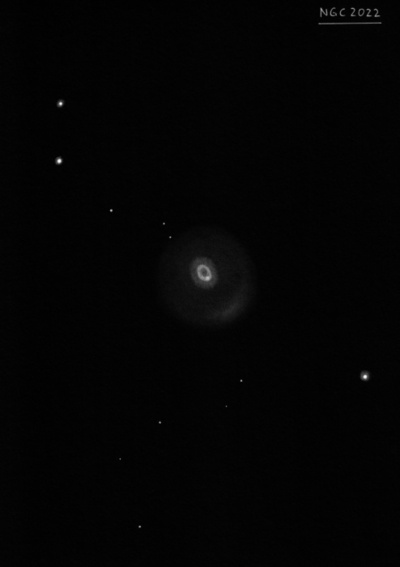
William Herschel discovered NGC 2022 = H IV-34 = h365 on 28 Dec 1785 (sweep 496) and described it as "cB, vS, like a star with a large diameter. With 240 it appeared almost like a planetary nebula, but very ill defined, and little elongated. Nearly of equal brightness throughout, except at the edges." John Herschel wrote (sweep 121, 19 Jan 1828), "Planetary neb, a little indistinct at the edges; rather oval and perhaps of a mottled light."
NGC 2022 was observed 5 times with Lord Rosse's 72", often in an attempt to resolve it, and the following notes were recorded:
11 Dec 1850: "It is I am nearly sure resolvable, probably it is a glob Cl. At times I fancied the centre a little darker and a star in the p part."
23 Oct 1851: "I strongly suspect annular, r[esolvable], one star especially seen in the p part.
28 Dec 1853: "...a B patch or a star?, it is near the edge of the neb. Some dark spot or spots certainly seen and at times I had the suspicion of a concentric ring or rings."
5 Jan 1877: "Seems a glob Cl, stars seen sparkling in it, oval sp nf. Edges v diffuse, especially sf, np edge more sharp. Proportion of diameters about 7:10."
William Lassell observed NGC 2022 in Jan. 1853 from Malta with his 24-inch equatorial reflector and commented, "a singular curdled-looking object, slightly and irregularly elliptical, with a sort of cordon [outer shell] running round parallel, but a little outside of its margin." A sketch was included in his 1854 MRAS paper (figure 2). Father Secchi sketched a slightly darker center in his 1856 "Osservazioni di Nebulose". In 1862 and 1863, Lassell aos observed the planetary through his 48-inch on Malta and noted "with 1060x some brighter patches or nodules seem to exist in it, but nothing more can be made out.” His sketch showed the central star and a thin outer ring separated by a thin dark gap.
Based on a Crossley photograph, Curtis (1918) reported, "Sharp stellar nucleus about mag 13, surrounded by an elliptical ring 22"x17" in outside dimensions in pa 29°. Outside this is an oval disk of fainter matter 28"x27". The brightest parts are the two masses at the ends of the major axis of the inner ring."
300/350mm - 13" moderately bright, high surface brightness. No internal structure was visible.
400/500mm - 17.5" (2/2/02): immediately picked up at 100x as a very small, bluish-gray "egg" of fairly high surface brightness. Good contrast gain with OIII filter. At 380x (unfiltered), it appeared as fairly bright, clearly elongated SSW-NNE, ~27"x20". The surface brightness was irregular or mottled with a slightly brighter rim and darker center giving a weakly annular appearance. The rim seems to have a couple of slightly brighter spots and the ends of the minor axis are slightly dimmer. No sign of a central star.
17.5" (12/8/90): fairly bright, slightly elongated 4:3 ~SSW-NNE, about 30" diameter. Appears slightly annular at 412x with a brighter rim. No central star seen at this power.
600/800mm - 24" (1/25/14): at 500x appeared as a fairly bright knotty annulus, slightly elongated SW-NE with fascinating structure. The rim was clearly brighter along an ~200° arc running from the southwest counterclockwise to the northeast. Very small brighter knots were definite at the SW and NE ends and perhaps a slight brightening at the NW edge. In general, though, the rim appeared mottled and sparkling though clearly dimmer along the southeast side, giving a "C" appearance. At 750x, the darker center was also irregular in surface brightness and occasionally, an extremely faint central star sparkled.
900/1200mm - 48" (2/21/12): at 488x, this bright, double-shell planetary contains a bright oval ring oriented SSW-NNE, ~23"x18". The annulus is fairly thin with a relatively large, darker central hole, though the contrast is fairly low. At the exact center is a faint central star (close to 16th mag?). The ring has an irregular surface brightness; slightly brighter at the ends of the major axis, particularly the SW end (knot or thicker?), and slightly fainter along the minor axis. Surrounding the ring is a fainter and rounder outer shell, ~30" diameter. The outer shell was surprisingly prominent and exhibited a pinkish hue.
Notes by Steve Gottlieb